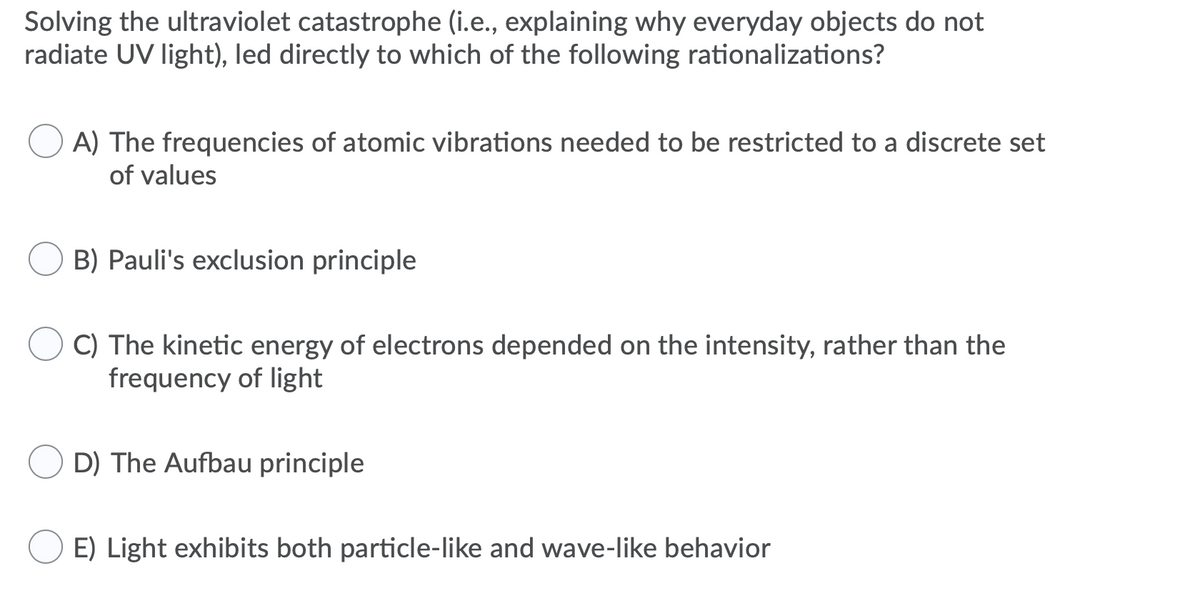Solving the ultraviolet catastrophe (i.e., explaining why everyday objects do not radiate UV light), led directly to which of the following rationalizations? A) The frequencies of atomic vibrations needed to be restricted to a discrete set of values B) Pauli's exclusion principle C) The kinetic energy of electrons depended on the intensity, rather than the frequency of light D) The Aufbau principle E) Light exhibits both particle-like and wave-like behavior
Solving the ultraviolet catastrophe (i.e., explaining why everyday objects do not radiate UV light), led directly to which of the following rationalizations? A) The frequencies of atomic vibrations needed to be restricted to a discrete set of values B) Pauli's exclusion principle C) The kinetic energy of electrons depended on the intensity, rather than the frequency of light D) The Aufbau principle E) Light exhibits both particle-like and wave-like behavior
Physical Chemistry
2nd Edition
ISBN:9781133958437
Author:Ball, David W. (david Warren), BAER, Tomas
Publisher:Ball, David W. (david Warren), BAER, Tomas
Chapter9: Pre-quantum Mechanics
Section: Chapter Questions
Problem 9.39E: The photoelectric effect is used today to make light-sensitive detectors; when light hits a sample...
Related questions
Question

Transcribed Image Text:Solving the ultraviolet catastrophe (i.e., explaining why everyday objects do not
radiate UV light), led directly to which of the following rationalizations?
A) The frequencies of atomic vibrations needed to be restricted to a discrete set
of values
B) Pauli's exclusion principle
C) The kinetic energy of electrons depended on the intensity, rather than the
frequency of light
D) The Aufbau principle
E) Light exhibits both particle-like and wave-like behavior
Expert Solution
This question has been solved!
Explore an expertly crafted, step-by-step solution for a thorough understanding of key concepts.
This is a popular solution!
Trending now
This is a popular solution!
Step by step
Solved in 3 steps

Knowledge Booster
Learn more about
Need a deep-dive on the concept behind this application? Look no further. Learn more about this topic, chemistry and related others by exploring similar questions and additional content below.Recommended textbooks for you

Physical Chemistry
Chemistry
ISBN:
9781133958437
Author:
Ball, David W. (david Warren), BAER, Tomas
Publisher:
Wadsworth Cengage Learning,

Principles of Modern Chemistry
Chemistry
ISBN:
9781305079113
Author:
David W. Oxtoby, H. Pat Gillis, Laurie J. Butler
Publisher:
Cengage Learning

Chemistry: Principles and Reactions
Chemistry
ISBN:
9781305079373
Author:
William L. Masterton, Cecile N. Hurley
Publisher:
Cengage Learning

Physical Chemistry
Chemistry
ISBN:
9781133958437
Author:
Ball, David W. (david Warren), BAER, Tomas
Publisher:
Wadsworth Cengage Learning,

Principles of Modern Chemistry
Chemistry
ISBN:
9781305079113
Author:
David W. Oxtoby, H. Pat Gillis, Laurie J. Butler
Publisher:
Cengage Learning

Chemistry: Principles and Reactions
Chemistry
ISBN:
9781305079373
Author:
William L. Masterton, Cecile N. Hurley
Publisher:
Cengage Learning

Chemistry
Chemistry
ISBN:
9781305957404
Author:
Steven S. Zumdahl, Susan A. Zumdahl, Donald J. DeCoste
Publisher:
Cengage Learning

Principles of Instrumental Analysis
Chemistry
ISBN:
9781305577213
Author:
Douglas A. Skoog, F. James Holler, Stanley R. Crouch
Publisher:
Cengage Learning

Chemistry for Engineering Students
Chemistry
ISBN:
9781337398909
Author:
Lawrence S. Brown, Tom Holme
Publisher:
Cengage Learning